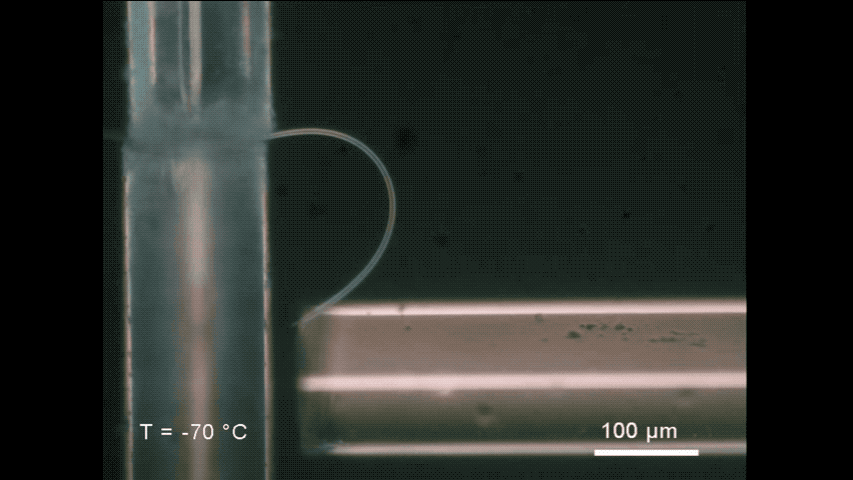Scientists create super-bendy ice
Weird ice strands bend into a loop and snap back into shape.

Ice is stiff and brittle — if you bend it, it will snap in two. Right? Not quite. Researchers just found that when grown in tiny strands, ice can defy its reputation for breakability, becoming so elastic it can even bend into a loop, according to a new study.
These ice microfibers are so bendy that they are near the theoretical limit for ice elasticity. Perhaps even cooler, the scientists who grew the bendy ice think that their teensy ice strands could lead to both an avalanche of new ways to better understand ice in its natural state and more efficient technology for transmitting light.
In theory, ice in the real world could be just as bendy as the researchers' ice, but defects such as cracks and misalignments of crystals makes naturally occurring ice far more brittle.
Related: The 18 biggest unsolved mysteries in physics
The maximum theoretical elastic strain of water ice — or the percentage of its size by which it can be stretched or bent before returning to its original shape — is about 15%. That means ice could theoretically get stretched out by an additional 15% of its length and still spring back. The highest elastic strain previously recorded for ice, however, was only around 0.3%. By creating ice with as few structural imperfections as possible, the researchers made ice microfibers with a maximum elastic strain of 10.9%.
To create their super-flexible ice, the team pumped water vapor into an ultracold chamber that was chilled to around minus 58 degrees Fahrenheit (minus 50 degrees Celsius). Water molecules, because they have a slight positive charge on one side where their hydrogen atoms are and a negative charge on the other where their oxygen atom is, were then attracted by the charged tip of a tungsten needle, where they crystallized, forming tiny fibers just a few micrometers in width — a fraction of the breadth of a human hair.

Because of their tiny size and their rapid formation, these fibers contained very few imperfections. After cooling the fibers even more, to between minus 94 F (minus 70 C) and minus 238 F (minus 150 C), the team measured their elastic strain. They found that the fibers were more elastic than any other type of water ice ever measured before — The fibers could be bent into partial circles, and all of them sprang back to their original shape after being released. The team say that while many investigations have grown ice whiskers like theirs in the lab, previous studies focused more on the way the crystals grew and the shape they took, and not their remarkable mechanical properties.
Get the world’s most fascinating discoveries delivered straight to your inbox.
By examining the structure of the ice strands, the team discovered that parts of the fibers took on a different, denser form when placed under stress. The researchers believe that the stress could have caused the strands to change phase into a more durable crystal structure. This observation, if followed up by more experiments with their bendy ice, could give the researchers a new way to study ice that has been placed under pressure, whether that's in glaciers, on comets or on airplanes and wind turbines.
The researchers also noted that their ice strands were extremely transparent, so they attached a tiny flashlight to the ends of each strand, and saw that light was transmitted through the fibers as easily as it is through state-of-the-art waveguides, which are devices used to aid in light transmission by acting as conduits. Low-temperature requirements would make the ice fibers hard to use in most equipment, but they could still potentially be used in some below-freezing apparatuses, such as very precise low-temperature light sensors.
The researchers published their findings July 9 in the journal Science.
Originally published on Live Science.

Ben Turner is a U.K. based writer and editor at Live Science. He covers physics and astronomy, tech and climate change. He graduated from University College London with a degree in particle physics before training as a journalist. When he's not writing, Ben enjoys reading literature, playing the guitar and embarrassing himself with chess.


